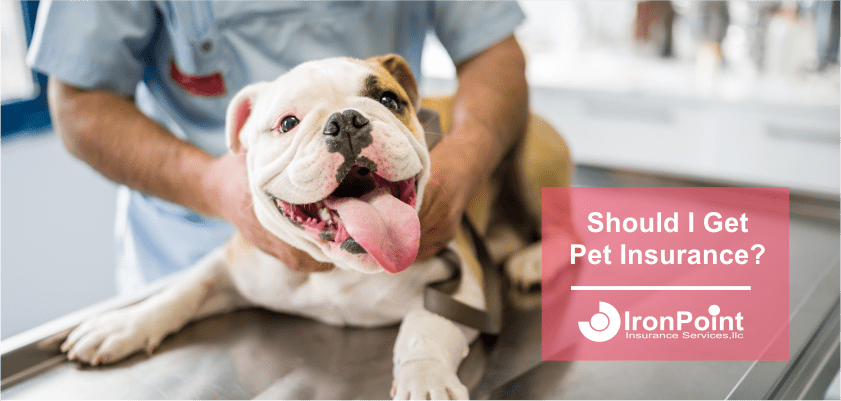Should I Buy Pet Insurance? A Look at Pros, Cons, and Costs

Your dog needs emergency surgery. The vet says it’ll cost $4,500.
Do you have that money readily available? If not, you’re facing every pet owner’s worst nightmare—choosing between your pet’s health and your financial stability.
This scenario is exactly why 1 in 3 pet owners are now asking: “Should I buy pet insurance?” With veterinary costs rising 6% annually and advanced treatments becoming standard, it’s a question worth answering carefully.
Here’s everything you need to know to make the right decision for your situation.
What Pet Insurance Covers (The Quick Version)
Pet insurance works like health insurance for your furry family members. You pay monthly premiums, and the insurance company reimburses you for covered veterinary expenses.
Most policies cover:
- Accidents (broken bones, cuts, poisoning)
- Illnesses (cancer, infections, chronic conditions)
- Emergency treatments and surgeries
- Prescription medications
- Diagnostic tests (X-rays, blood work, MRIs)
Optional wellness coverage includes routine care like vaccines, checkups, and dental cleanings—but you’ll pay extra for these add-ons.
Why Pet Owners Are Asking This Question Now
Modern veterinary care has transformed dramatically. Today’s animal hospitals offer the same advanced treatments as human hospitals—MRIs, chemotherapy, orthopedic surgery, even organ transplants.
The result? Treatment costs that can shock even prepared pet owners:
- Emergency surgery: $3,000–$7,000
- Cancer treatment: $5,000–$20,000+
- ACL repair: $3,500–$6,000
- Heart surgery: $8,000–$15,000
Here’s the reality: 63% of pet owners say they couldn’t afford a $5,000 veterinary emergency without going into debt or using credit cards.
Understanding these potential pet insurance costs is crucial when evaluating whether insurance makes financial sense.
The Pros of Buying Pet Insurance
Pet insurance offers several key advantages:
- Financial protection when you need it most – Pet insurance transforms unpredictable, large expenses into manageable monthly payments. Instead of facing a $6,000 surgery bill, you might pay $1,600 out-of-pocket with an 80% reimbursement plan.
- Peace of mind for medical decisions – With insurance, you can focus on what’s best for your pet instead of what you can afford. That specialist referral becomes a real option. The expensive diagnostic test gets approved without financial anxiety.
- Access to better care and early treatment – Insured pets often receive better outcomes because owners don’t delay treatment due to cost concerns. Early intervention typically means better results and, ironically, lower total costs.
- Predictable monthly budgeting – A $45 monthly premium is easier to plan for than wondering if this month will bring a $4,000 emergency bill.
Example cost breakdown for a $6,000 surgery:
- Surgery cost: $6,000
- Annual deductible: $500
- Your 20% copay: $1,100
- Total you pay: $1,600 instead of $6,000
The Cons of Buying Pet Insurance
Before committing to pet insurance, consider these important limitations:
- Pre-existing conditions aren’t covered – If your pet already has any diagnosed health issues, related treatments won’t be covered. This includes everything from hip dysplasia to allergies—even if they were just noted in passing during a routine exam.
- Premiums increase over time – Your monthly costs will rise as your pet ages. A policy costing $35/month for a young dog might jump to $85/month by age 8. Some companies cap increases, but many don’t.
- You’ll still have out-of-pocket costs – Even with good coverage, expect to pay annual deductibles ($200–$1,000), copays (10–30% of each bill), exam fees (often not covered), and certain medications and treatments.
- Wellness coverage often doesn’t pay off – The math rarely works in your favor. If wellness add-ons cost $25/month ($300 annually) but your healthy young pet only needs $180 in routine care, you’re paying extra for convenience.
Who Benefits Most from Pet Insurance
Pet insurance typically makes the most sense for:
- New pet owners with young, healthy pets – This is the sweet spot. Enrolling a healthy puppy or kitten locks in low rates and avoids pre-existing condition exclusions. The younger your pet when you enroll, the better.
- Owners of high-risk breeds – Bulldogs (breathing issues), German Shepherds (hip dysplasia), Golden Retrievers (cancer), and Maine Coons (heart disease) face expensive health challenges. If your breed appears on veterinary “expensive to treat” lists, insurance often pays for itself.
- People without emergency savings – If you can’t easily cover a $5,000 vet bill, insurance makes financial sense. It converts unpredictable expenses into predictable monthly payments.
- Families who want maximum treatment options – When your pet is truly family, you want access to the best possible care regardless of cost. Insurance removes money as the primary decision factor.
When Pet Insurance May Not Be Worth It
Pet insurance probably isn’t the right choice if:
- Your pet is older with existing health issues – Premiums are highest when pets need care most. If your 10-year-old dog already has arthritis, you’ll pay high premiums while arthritis-related treatments remain excluded.
- You have substantial emergency savings – Pet owners with $10,000+ in readily available savings might prefer self-insuring, especially for routine care and minor emergencies.
- You have a very young, indoor-only cat – Healthy indoor cats have lower accident and illness rates. The math may favor paying out-of-pocket, at least initially.
Alternatives to Pet Insurance
If pet insurance doesn’t seem right for your situation, consider these options:
- Dedicated pet savings account – Set aside $50–100 monthly in a high-yield savings account earmarked for pet expenses. You keep unused money and earn interest, but you’re vulnerable if major expenses hit before you’ve saved enough.
- Veterinary discount plans – Plans like Banfield’s Optimum Wellness cost $30–60 monthly and cover routine care at participating clinics. Good for predictable expenses, useless for emergencies.
- Credit options – CareCredit offers 0% financing for 6–18 months on veterinary expenses. Helpful for immediate cash flow, but miss a payment and interest rates jump to 26%+.
- Hybrid approach – Maintain a smaller emergency fund ($2,000–3,000) plus accident-only insurance. This covers routine expenses while protecting against major injuries at lower premium costs.
Decision Framework: Is Pet Insurance Worth It for You?
Making the right decision about pet insurance comes down to honest self-assessment:
Ask Yourself These Key Questions:
- Can you afford a $5,000+ emergency tomorrow without affecting essential expenses?
- Is your pet young and healthy enough to qualify for lower premiums?
- Do you prefer predictable monthly costs over unpredictable large bills?
- How much would you spend to save your pet’s life?
When Shopping for Insurance
Compare these factors beyond just price when evaluating what’s covered:
- Reimbursement rates (70%, 80%, 90%)
- Annual coverage limits (some cap payouts)
- Deductible options (per-incident vs. annual)
- Waiting periods for illness coverage
- Customer reviews for claim processing speed
Frequently Asked Questions
Should I Buy Pet Insurance for an Older Pet?
It depends on their current health and your budget. If your 8-year-old pet is healthy, insurance can still provide value—but premiums will be higher and increase faster. Avoid insurance for pets with existing health issues, as related treatments won’t be covered.
Is Pet Insurance Worth It for Dogs vs. Cats?
Dogs typically benefit more from insurance due to higher accident rates and breed-specific health issues. However, cats can develop expensive conditions like kidney disease or cancer. Indoor-only cats have lower risk profiles than outdoor cats or dogs.
What Are the Biggest Pros and Cons of Pet Insurance?
The biggest advantage is financial protection against unexpected major expenses, allowing you to make medical decisions based on your pet’s needs rather than your bank account. The biggest disadvantage is that pre-existing conditions aren’t covered, and premiums increase significantly as pets age—exactly when you’re most likely to need coverage.
Should I Get Pet Insurance Right Away?
Yes, if you’re considering it at all. Most policies have waiting periods (14–30 days), and any health issues that develop during that time become pre-existing conditions. The best time to buy pet insurance is when your pet is young and healthy.
The Bottom Line: Should You Buy Pet Insurance?
Pet insurance makes sense if:
- You can’t easily afford $5,000+ in emergency vet bills
- Your pet is young and healthy
- You own a high-risk breed
- You want access to advanced treatments without financial stress
- You prefer predictable monthly expenses
Pet insurance probably isn’t worth it if:
- You have substantial emergency savings (>$10,000)
- Your pet is older with existing health issues
- You’re comfortable with pay-as-you-go veterinary expenses
- You prefer investing premium money elsewhere
The honest answer: Pet insurance isn’t right for everyone, but it can be a financial lifesaver for the right pet owner in the right situation.
The key is making an informed decision based on your specific circumstances—your pet’s age and health, your financial situation, and your comfort with risk. Because when that emergency happens, you’ll want to focus on helping your furry family member, not worrying about the bill.

Quote & Pet Insurance Online Today
Start a pet insurance quote today & be prepared for the unexpected. We make it fast, safe, and secure.
- Let’s Get Started!
-
Have an Agent Call
- Compare Business Quotes
-
Business Owners’ Policy
-
Workers’ Compensation
-
General Liability
-
Commercial Auto
-
Cyber Liability
- Personal Insurance
-
Auto
-
Home / Condo / Renters
-
Motorcycle
-
Classic Car
-
Boat / Yacht
- Quote & Buy Online
-
Small Business Insurance
-
Mexico Auto Insurance
-
Pet Insurance
Call 1-877-334-7646 to speak with an insurance specialist.
Key Takeaways:
- Pet insurance protects against major vet bills: It helps cover costly emergencies and illnesses, turning unpredictable expenses into manageable monthly payments.
- Best for young or high-risk pets: Younger, healthy animals and breeds prone to expensive conditions benefit most from early enrollment.
- Not for every situation: Owners with large savings or older pets with pre-existing conditions may be better off self-insuring or saving monthly for future care.